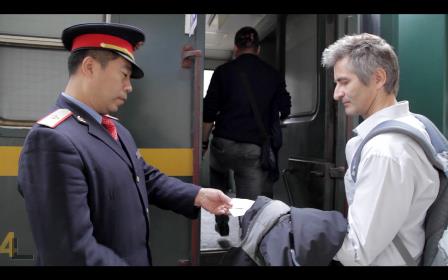Peter Pecotić boarding the train to Jiamusi.
A tiger released into the wild by Russian President Vladimir Putin has made its way over the Russian border into Eastern China, causing quite a stir among locals.
It wasn’t long until the resulting media coverage caught the eye of Australian producer Peter Pecotic and his filmmaking partner Xiaoqing He (Qing) – just as they were discussing the possibility of an Australian/Chinese documentary co-production.
“Xiaoqing and I were discussing a co-production, not for that long, but we just came to this idea about producing some documentaries about China,” he tells IF on the phone from Shanghai. “It’s such a diverse country, and what we noticed internationally is that it in media coverage and even in film, it doesn’t really reflect contemporary China in all of its diversity.
“So we were thinking about making a series of films in the border regions where the cultures have confluences, where they mix; and explore the human and natural landscapes of all of these broader regions all in the light of exploration and showing a true sense of contemporary China.
“We were discussing that and then about six weeks ago we were looking at newspaper article in the Shanghai Daily which had an article about Vladimir Putin’s tiger which was released into the wilderness… and then had swum across the Amur river and came into Chinese territory.
“This was a very big buzz in Chinese media and for the Chinese people, because a tiger is an auspicious animal and also a tiger that is personally released by the President of Russia – which is one of the major powers sand countries that neighbour China – this is quite a big deal. But it captured our imagination that this would be the perfect vehicle to explore that particular border and to explore by following that particular tiger.”
Pecotic and Qing thought the tiger’s adventures and the reactions from both the Russians and the Chinese would provide an interesting framework for them to explore their original idea of capturing contemporary China in a new and interesting way.
The very night they read the article, they boarded a plan to Harbin, then took the ten-hour train the following day to Luobei County, which borders Russia.
Though the film follows the tiger’s footsteps, Pecotic is quick to point out the aim of the production was never to actually locate or film it. Rather, the story is about the cultural significance of the animal crossing the border and the impact it has had on both cultures. It also takes a look at some of the programs in place to manage any potential conflict between predatory animals and human beings.
“We went from Shanghai to Vladivostok to be with the tiger inspection teams, as well as a non-government organisation which is all about helping conflict situations with tigers and other predatory animals in the Russian far east, like leopards and bears and other predatory animals that come into contact with humans, and ways to resolve those conflicts” Pecotic says.
“These are fascinating non-government organisations that work in protection but also effectively conflict resolution.”
The team turned to crowd-funding to raise principal funds but also to generate awareness of the project and what they were trying to achieve. As a result, they enjoyed almost un-heard of access to reserves which ordinarily don’t allow humans as well as being privy to the tiger’s exact whereabouts (monitored via Russian satellites and kept top secret from Chinese media).
“We went to remote regions to be with former Russian hunters and trappers who had reformed into becoming conservationists and rangers. So while we are effectively filming and interviewing, we are also following and sharing their lives for a short amount of time. This is what the film is about."
“There are environmental elements, and things about conservation and the reintroduction of species but it’s really about these human interest stories. About how people on the different sides of the border whose cultures are so diverse – you can’t imagine how diverse it is going just a kilometre –virtually metres – and you go from North East China which was once Manchuria into effectively Europe.
“What we’ve seen and hopefully illustrated is how these people have been brought together and how their lives have just been touch by this wild animal that doesn’t recognise borders and differences in culture.”
You can find more about the film (tentatively titled In Search of Putin’s Tiger) at the project’s Facebook Page or at their crowd-funding site


